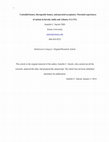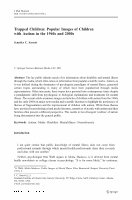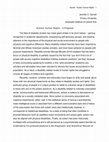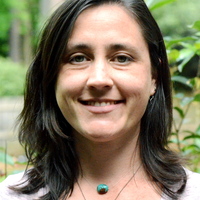Papers by Jennifer Sarrett
Frontiers in Public Health, 2015
Cultural Sociology of Mental Illness: An A-to-Z Guide, 2014

Culture, medicine and psychiatry, Jan 13, 2015
The home is a critical place to learn about cultural values of childhood disability, including au... more The home is a critical place to learn about cultural values of childhood disability, including autism and intellectual disabilities. The current article describes how the introduction of autism into a home and the availability of intervention options change the structure and meaning of a home and reflect parental acceptance of a child's autistic traits. Using ethnographic data from Kerala, India and Atlanta, GA USA, a description of two types of homes are developed: the custodial home, which is primarily focused on caring for basic needs, and the therapeutic home, which is focused on changing a child's autistic traits. The type of home environment is respondent to cultural practices of child rearing in the home and influences daily activities, management, and care in the home. Further, these homes differ in parental acceptance of their autistic children's disabilities, which is critical to understand when engaging in international work related to autism and intellectual ...

Culture, medicine and psychiatry, 2015
Explanatory models (EMs) are the way people explain the presence and meaning of an illness or dis... more Explanatory models (EMs) are the way people explain the presence and meaning of an illness or disability and are reliant on and reflective of culturally specific values of normalcy, disability, health, and illness. EMs about autism spectrum disorder (ASD) are particularly revealing because there is no known cause, and so people can explain this disability in ways more appropriate for and useful to them. This article presents caretaker EMs about children with autistic characteristics in Kerala, India. I argue that the reliance on biological, but not genetic, causal models is reflective of the state's high access to biomedical heath care. These EMs are used to deflect the stigma of 'bad blood' and reflect a nuanced relationship between stigma and biological EMs. Understanding how caretakers talk about ASD and related conditions is critical for anyone interested in engaging in crosscultural or international autism-related work.

Neurodiversity, the advocacy position that autism and related conditions are natural variants ... more Neurodiversity, the advocacy position that autism and related conditions are natural variants of human neurological outcomes that should be neither cured nor normalized, is based on the assertion that autistic people have unique neurological differences. Membership in this community as an autistic person largely results from clinical identification, or biocertification. However, there are many autistic individuals who diagnose themselves. This practice is contentious among autistic communities. Using data gathered from Wrong Planet, an online autism community forum, this article describes the debate about self-diagnosis amongst autistic self-advocates and argues for the acceptance of the practice in light of the difficulties in verifying autism as a ‘natural kind.’ This practice can counteract discriminatory practices towards and within the autistic community and also work to verfiy autistic self-knowledge and self-expertise. This discussion also has important implications for other neurocommunities, neuroethical issues such as identity and privacy, and the emerging field of critical autism studies.
Disability Studies Quarterly, Oct 18, 2012
Watters questions the universality of mental illness and warns of the harms that accompany the ex... more Watters questions the universality of mental illness and warns of the harms that accompany the exportation of Western typologies to non-Western cultures. He is particularly concerned that these effects will be exacerbated by the upcoming revisions of the Diagnostic and Statistical Manual of Mental Disorders (DSM-V). Building on his examination of non-Western practices, Watters exposes the historical instability of mental health classifications in North America to question the validity of current DSM categories. Although Watters’ warnings about the dangers of the globalisation of the DSM are persuasive, they may be overreaching as our examination of the successful incorporation of Western created autism services, information, and interventions in the developing world suggests.

The lay public inherits much of its information about disability and mental illness through the m... more The lay public inherits much of its information about disability and mental illness through the media, which often relies on information from popular scientific works. Autism, as it was defined during the dominance of psychogenic paradigms of mental illness, generated certain tropes surrounding it, many of which have been popularized through media representations. Often inaccurate, these tropes have persisted into contemporary times despite a paradigmatic shift from psychogenic to biological explanations and treatments for mental illness. The current article examines images and articles of children with autism from the 1960s and the early 2000s in major news media and scientific literature to highlight the persistence of themes of fragmentation and the imprisonment of children with autism. While these themes have persisted in psychological and media literature, narratives of people with autism and their families often present a different perspective. This results in two divergent ‘realities’ of autism being disseminated into the general public.

Journal of Medical Humanities, Jan 1, 2011
The lay public inherits much of its information about disability and mental illness through the m... more The lay public inherits much of its information about disability and mental illness through the media, which often relies on information from popular scientific works. Autism, as it was defined during the dominance of psychogenic paradigms of mental illness, generated certain tropes surrounding it, many of which have been popularized through media representations. Often inaccurate, these tropes have persisted into contemporary times despite a paradigmatic shift from psychogenic to biological explanations and treatments for mental illness. The current article examines images and articles of children with autism from the 1960s and the early 2000s in major news media and scientific literature to highlight the persistence of themes of fragmentation and the imprisonment of children with autism. While these themes have persisted in psychological and media literature, narratives of people with autism and their families often present a different perspective. This results in two divergent 'realities' of autism being disseminated into the general public.

ahead.org
The field of disability studies has made great strides in its short history -gaining recognition ... more The field of disability studies has made great strides in its short history -gaining recognition in academic departments, empowering self-advocacy groups, and drawing attention to the importance of the physical and social environment to people with physical and cognitive difference. Many disability related theories have been inspired by feminist and African American studies scholars, and most have centered on people with physical impairments. Disability scholar Michael Bérubé (2010) explains that the field's focus on physical disability is partially caused by the fact that "you don't find a lot of people with severe cognitive disabilities holding academic positions" and that, because of fears surrounding speaking for another in this "post-something" academic era, scholars and advocates have been reluctant to discuss the issues encountered in this population. As a result, a disability related model of human rights has struggled to include all ranges of intellect and cognition.











Uploads
Papers by Jennifer Sarrett